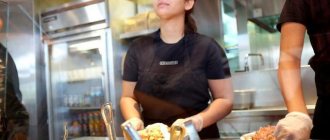Hello friends! My name is Boris, I set up targeted advertising, and in my free time I go hiking
From the series of “long cases”
March 8 is behind us, and I decided to talk about the progress of my very good friend’s project. As they say, the project brings people closer together.
We are talking about a hype project, as we like to call it. After all, so much work was put into it, several sleepless nights and dead nerve cells
We come to St. Petersburg for strawberry bouquets and try the juiciest strawberries in St. Petersburg!
Costs and profits
One-time investment in opening a company for the production of vegetable and fruit bouquets - 170,000 rubles. The estimate does not take into account working capital, which is necessary to maintain the business until it breaks even. The monthly estimated profit is about 100 thousand rubles per month in the first year after the payback period.
Start-up costs: approximate calculation for Kazan
| Expense item | Amount, ₽ |
| Business registration | 900 |
| Equipment | 68’100 |
| Design and printing of advertising materials | 15’000 |
| Advertising campaign | 11’000 |
| Creation of an online store | 40’000 |
| Total | 170’000 |
Monthly costs
| Expense item | Amount, ₽ |
| Tax deductions and insurance contributions | 5’000 |
| Consumables | 30’000 |
| 12’000 | |
| Staff salaries | 50’000 |
| Rent premises on the outskirts of the city (30 m2) | 15’000 |
| Electricity, communications, internet | 3’000 |
| Logistics | 5’000 |
| Total | 120’000 |
Bouquets on the knee
“A magic kick,” as Nazarova put it, was given to her in the fall by a friend who had accumulated capital. He didn’t know what to do with the money, and invited Anna to bring some of her “crazy ideas” to life. She chose vegetable bouquets.
A happy life with the investor did not work out: two weeks later the friends quarreled, and Anna returned the 40,000 rubles with which they planned to start. But I no longer wanted to push the idea into a box. Coincidentally, at that time, a manager from Boomstarter approached Nazarova, he proposed launching a campaign to raise money for “Kuru & Buckwheat,” Nazarova’s culinary project, with which she sometimes performed at restaurant days. But she was more interested in creating unusual bouquets, and so Nazarova launched a crowdfunding campaign for the purchase of vegetables and equipment.
There was a day and a half left before the submission of materials for crowdfunding, and Nazarova had not made a single new bouquet. In a panic, she went to the Sennaya Market, swept away several bags of vegetables worth 5,000 rubles from the shelves, filled up the entire kitchen at home and called a photographer friend: “Can you help me take a picture?” He had free time in the studio in three hours.
By evening, Nazarova managed to make three bouquets (now she spends 5 to 15 minutes on each). They were again held together somehow - with sticks, ropes and other materials found at hand. But Boomstarter visitors only saw the picture, not the insides, and in a month in October, the “Very Good” project raised 90,000 rubles. True, the money was paid only in January - before that Nazarova invested her own 40,000 rubles.
Nazarova spent half of the money collected on the purchase of a refrigerator and vegetables, and spent another 8,000 rubles on advertising: she started a VKontakte group, which, along with the project’s Instagram, is now the main sales channel. This was the first and last online advertising of the project; it brought only two buyers. Soon Nazarova invented another method: she made a bouquet, put business cards in her pocket and rode the subway back and forth. She gave her contact information to everyone who was interested. In the first month, she recouped the investment and received 40,000 rubles; by the end of the second month, the monthly turnover was about 60,000 rubles, and Nazarova decided to quit her job. Because of the sanctions, prices for vegetables jumped by 50%, so she decided not to rent a workshop, but to spend everything on purchases.
At first, Nazarova made bouquets in the kitchen and delivered them to the metro herself, but in March 2020 she had to hire an assistant, and friends began to help with delivery. The business grew slowly, but in April the founder of “Very Good” had a breakthrough. “As I remember now, on Friday at three o’clock in the afternoon I wrote a short letter to Ilya Varlamov, who launched the “Business in Crisis” project on his LiveJournal,” Nazarova thought that she would have to wait a long time for an answer, because Varlamov warned that publications were scheduled for a month in advance. She received a message from him 15 minutes later: “Yes, cool, write an article.” Nazarova wrote the text in an hour, and the very next day it appeared on the blog.
“The whole of Moscow was on edge,” recalls Nazarova. She was written by both ordinary users who immediately wanted to receive a bouquet of vegetables in the capital, and potential investors and franchisees. There was even a man who drove a Sapsan between cities every four days: he became the first courier, bringing 6 bouquets to Moscow at a time. Experts explain this attention to the project by the boom in healthy lifestyles in large Russian cities. “The demand for healthy eating has led to the popularity of vegetable bouquets. In the age of genetic engineering, literally anything can be included in a bouquet or composition - from miniature pumpkins to gherkins and lettuce. One of our clients even asked the florists to make a bouquet according to a specific recipe. This is a funny trend,” notes Talia Akhmetova, spokeswoman for the flower delivery service Florist.ru.
Having fallen into the trend, Nazarova did not immediately cope with the flow of proposals. She was afraid of the franchisees - she was afraid of a loss of quality, and of investors too - what if they left the project and sold the share to outsiders. “I believed in my current partner Svetlana Zueva. She was deeply pregnant then,” recalls Nazarova. She chose Zueva as a partner for the launch in Moscow - in June 2020, Very Good opened its first workshop there. Zueva already had experience in business: she managed a chain of fitness gyms, which has now degenerated into EMS training at home.
Permits and documents
No special permits are required for this business. We recommend that you first open an online store, and then a bouquet retail outlet: it will become a logical development of your business when you develop a client base and become widely known.
Business registration
Register as an individual entrepreneur with the tax service at your place of residence. Choose a simplified taxation system. OKVED code 47.21 Retail trade in fruits and vegetables.
List of basic documents for registration
- Application for state registration of an individual as an individual entrepreneur (form No. P21001)
- Copy of Russian passport
- Receipt for payment of state duty
Equipment
If you don’t buy special expensive equipment, you can get by with a minimal set:
| Equipment | Cost, ₽ |
| Set of professional knives | 10’000 |
| Packaging and decorative elements | 8’000 |
| Long wooden skewers or toothpicks | 100 |
| Packing table | 5’000 |
| Racks for storing ready-made bouquets | 8’000 |
| Computer or laptop | 15’000 |
| Refrigerator for perishable fruits | 20’000 |
| Other tools and small items | 2’000 |
| Total | 68’100 |
How to make a fruit bouquet with your own hands in 15 minutes
A fruit bouquet is a great opportunity to please your mother on March 8th. Handmade gifts are always dearer to the heart. Fortunately, florists and folk craftsmen have come up with a lot of possibilities for new surprises. Here are instructions on how to make a delicious bouquet in 15 minutes. Time has passed.
- Wipe the lemon, kiwi, grapefruit and 3 apples with a damp paper towel. Dry with a kitchen towel.
- Cut the top off the grapefruit. Cut the lemon and kiwi in half. Pack each cut in cling film. So, 7 minutes have passed.
- Place the fruit on long skewers. It is better for the fruit to be on the table. Apples and grapefruit will contain 3 sticks each, lemons and kiwis will contain 2 sticks.
- Gather the sticks in your hand. Secure with tape. Basically, you've almost done it.
- Pack in gift paper. Stick flowers and green twigs into the empty spaces. Phew, we made it.
How to choose a supplier
Choosing a supplier of fruits and vegetables is an important point, because it is the basis of business. You need to negotiate low prices, despite the fact that it will not be possible to ensure a large volume of purchases at the initial stage. Find indoor and outdoor markets in your city and try to reach wholesalers through them. Visit local vegetable warehouses, compare prices and conditions.
Another option is to find product suppliers online, but this will make it difficult to assess the quality. You can make a test purchase of fruits and check it personally.
Where to begin
If you decide to open your own business selling food bouquets, your first steps should be:
- Assess the level of competition and demand in your city. To do this, you need to monitor advertisements on the Internet, Instagram pages of craftsmen who work in your city. Pay attention to the number of ad views. Do accounts with such works get a lot of subscribers and comments? What do they offer and at what price do they sell?
- After studying the proposal, think about your competitive advantages: what will be included in your work? What new things can you personally bring to this niche? Creative design, additional service, favorable price, etc.
- When you clearly decide what you will do, start mastering the skill and gaining experience. Master classes and training videos that are available for free on the Internet will help. But there is also paid training - both online and at master classes held in your city. You will spend no more than 5 thousand rubles on training. This is enough to learn the basics and get better at it.
- Draw up a rough business plan and think about your next steps. Will you be registering your business? What list of tools and equipment do you need to buy? How much will you spend on opening? How will you find clients and promote your products? How much do you plan to earn from this? All these questions need to be written down in order to avoid mistakes at the start and initially see the key points of the business.
- And finally, when you have considered all the issues and made an informed decision, you can move on to active action.
Staff
It is difficult to do all the work in such a business alone if you plan to reach serious volumes. Outsource the delivery of fruits, vegetables and the bouquets themselves to a logistics company. Website development and promotion to outsourcers. When there are more orders, you will need florists to assemble bouquets, as well as a site administrator. It will accept and process applications and fill the store with content. At the initial stage, its functions can also be performed by the owner.
- Assistant florist (1 person) — 20'000 ₽
- Site administrator/editor (remotely)— 10'000 ₽
- IT specialist (remotely, part-time) — 15'000 ₽
- Accountant (remotely, part-time) — 5'000 ₽
- Total — 50'000 ₽
What vegetables are included in bouquets and what is a “death bowl”
With the onset of summer, “Very Good” tries to buy more often from grandmothers: from them you can find the ultimate dream of florists - carrots, radishes and beets with tails.
Some of the ingredients are bought at markets, some at the Vegetable Shop, some in regular supermarkets. Anna insists that all vegetables and fruits are selected manually. In addition, due to sanctions, the crisis and seasonality, it is impossible to guarantee that the required type of pepper will not disappear from the shelf.
And although it is not customary to buy anything in advance (with the exception of products that can be frozen or dried), florists often come to the studio with bags of some vegetables because “they just couldn’t resist how beautiful they were.”
Anna says that she even began to eat less vegetables, only “second-class” ones are used, because the most aesthetically pleasing fruits are simply a pity.
In addition, in the workshop there is a “death bowl”, into which all vegetables unsuitable for bouquets fall. Florists are required to eat them or take them home to prepare something.
— By March 8, we didn’t calculate and bought an extra box of carrots and regularly sent them to our youngest florist Lena. As a result, Lena learned to cook carrot cutlets, carrot casserole, carrot soup, dumplings with carrots, carrot jam... The jam, by the way, is very tasty.
How to advertise a business
A new product or service requires more careful and detailed promotion on the market. and explanations to the target audience. Therefore, the marketing strategy will develop in two directions - promotion of the product itself and the brand.
An example of advertising bouquets of fruits and flowers
Before opening an online store, study the potential consumer, make a detailed portrait of him, a list of possible objections, which influences decision-making. Create a focus group and test the monitoring results. Your research will form the basis of your entire marketing campaign.
Connect modern promotion channels:
- Maintaining groups on social networks, advertising in communities with target audience
- Promotion in search results, contextual advertising in Yandex and Google
- Native advertising for bloggers
- Participation in exhibitions
- Bonus program for regular customers to ensure their return
- Promotions for the holidays
Evaluate the effectiveness of selected tools, test new ones, follow trends. For a business to flourish, an entrepreneur must be Julius Caesar, managing several processes at the same time. Only with this approach will you achieve success.
Improve your product and company continuously, reduce costs, but do not skimp on quality - this is the only way to become the best. For example, when increasing volumes, ask for discounts from suppliers: the product will not lose quality, but will cost less. Invent new ideas, draw inspiration abroad - only by developing yourself comprehensively will you develop your business.
Vegetable expansion
In Moscow, the business was slowly growing, but in St. Petersburg Nazarova still did everything herself. One summer day, Anna threw away the unfinished bouquet, sat down on the floor and began to roar. Everything in the kitchen was littered with vegetables and improvised materials; for four months she could not cook normal soup and was terribly tired of doing everything alone. “Oh my, I earn so much money, and I don’t even have my own corner,” Nazarova recalls her lamentations. Having cried her fill, she got up, found a room and set up a workshop there.
By the end of summer, there were already three florists in Moscow, four in St. Petersburg, and three more in Krasnoyarsk (an art critic friend became a partner there). They were taught personally by Nazarova. She says that she has come up with a unique technology that allows the bouquets to remain edible: “We are the world’s first vegetable floristry workshop.” Nazarova also invented a way to secure vegetables and decorations herself. According to her, you need to monitor the weight of vegetables and fruits, because if the bouquet is assembled incorrectly, it will not stand. Now she examines every bouquet made in the workshops: florists send photographs of them from three angles.
A new breakthrough in Moscow occurred after the “Moscow Autumn” festival, where “Very Good” florists spent about a month. An order was received for a bouquet from a woman for her son and daughter-in-law - he is a dark brunette, she is a light blonde. A couple of days after the order was handed over, Nazarova’s phone was turned off for several hours—it was dead. When she turned it on and went to Instagram, 800 new followers popped up and a bunch of comments: “Where can I buy your bouquet?” It turned out that the customer was Simona Yunusova, the mother of singer Timati. She posted the gift for her son on her account and put a link to “Very good.” During that month, Nazarova earned her first million rubles.
After entering Moscow and Krasnoyarsk, Nazarova decided to stop - for now she does not plan to connect new cities, she is afraid that it will not be possible to control the quality. She is also not sure that the service will be in demand in the regions. “Residents of megacities are always more open to new trends. But the majority of the population of Russian regions, as a rule, have summer cottages, which means that a bouquet of lettuce at the price of a florist will be unreasonably expensive for them,” agrees Talia Akhmetova from Florist.ru. In her opinion, the fashion for such bouquets is fleeting and vegetable arrangements, most likely, will not be able to occupy a significant share of the flower market.
Anna Khudalova, the founder of the company Vegato Studio (bouquets of vegetables and fruits), also notes the problem of expanding into the regions. She also says that from a financial point of view, working with vegetables and fruits is not much more profitable than working with flowers: “From the point of view of purchasing prices, in today’s exchange rate conditions, vegetables and fruits are more profitable. But these are also perishable products that need to be carefully selected, so on a production scale the difference is insignificant.” Vegato Studio chose a development path different from “Very Good” - large bouquets, for example, of tropical fruits, which are expensive.
Anna Nazarova, following her competitors, is ready to look for new ways of monetization. Even at the beginning of the project, she organized master classes via Skype - the most expensive one was held for 5,000 rubles for customers in Rublyovka, the cheapest for 3,500 rubles for Khabarovsk residents. But video tutorials take too much time, so Nazarova came up with a “recipe bouquet.” She films the process of creating a bouquet step by step and sends photo instructions to the buyer for 2,500 rubles. “Recipes” already bring in up to 20% of revenue. “I’m seriously thinking about training and the b2b market, because there are a lot of vegetable florists now, but no one knows how to work,” Nazarova says categorically about her industry colleagues.
Another direction is corporate orders. “The first one came in December 2014 at 10 pm. By 11 am the lady asked for 14 bouquets of gingerbread with the company logo. I didn’t sleep then,” recalls Nazarova. In addition to delivering bouquets, she is invited to work at corporate events. For example, a stand with bouquets appeared at the presentations of Land Rover and Mercedes: “There are pancakes with caviar and Martini Asti on long buffet tables, a violin quartet is playing, a Chanel fashion show is taking place, and here we are with vegetables.” According to Nazarova, bouquets were very popular among guests tired of typical presentations.
In July, “Very Good” decorated his first wedding: vegetables on the tables, on the walls and even in the bride’s bouquet. The new territory opens up great prospects for development: the volume of the Russian wedding services market is difficult to estimate, but it is over $100 million. Moreover, about 30% of players leave it every year, unable to make unusual offers to newlyweds. “Very Good” has everything in order with originality - a panda from a newscast goes into battle.
For the last two years, the delivery of vegetable bouquets has been successfully operating in St. Petersburg: Anna Nazarova began making extravagant bouquets at the height of the financial crisis, and in the end she not only succeeded, but also infected the whole country with the idea of giving eggplants and champignons instead of flowers. How to deal with imitators and what to do with competitors, is it possible to make borscht and guacamole from a vegetable bouquet, and what is a “death man’s bowl” - in the story of the founder of St. Petersburg.











